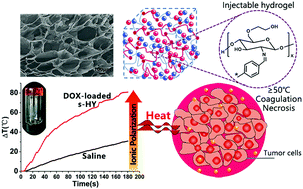An injectable ionic hydrogel inducing high temperature hyperthermia for microwave tumor ablation†
Abstract
Microwave tumor ablation is of clinical significance and has been considered as a promising cancer minimally invasive therapy. One of the challenges in this field is the optimization of the susceptible agent. Herein, a novel chitosan-based ionic hydrogel which can induce rather high temperature hyperthermia as a susceptible agent for microwave ablation is reported. Owning to the high porosity of the hydrogel, a strong ion confinement effect can be realized, therefore, strong polarization under microwave exposure is ensured for rapid heat generation. In addition, the as-synthesized hydrogel has negligible bio-toxicity and excellent spatial stability in vivo which can guarantee a reproducible therapeutic effect for repeated treatment. In vivo anti-tumor investigation has demonstrated that excellent therapeutic efficiency can be achieved after repeated microwave thermal therapy with a rather low power density (2.0 W, 2.45 GHz). Further, computer simulation was conducted to elucidate the microwave heating mechanism. Our investigation provides a biocompatible and stable agent for microwave tumor ablation and demonstrates its great significance for potential clinical application.



 Please wait while we load your content...
Please wait while we load your content...